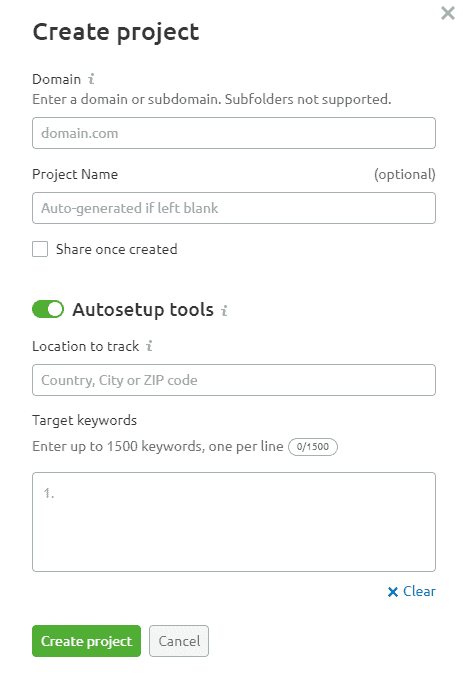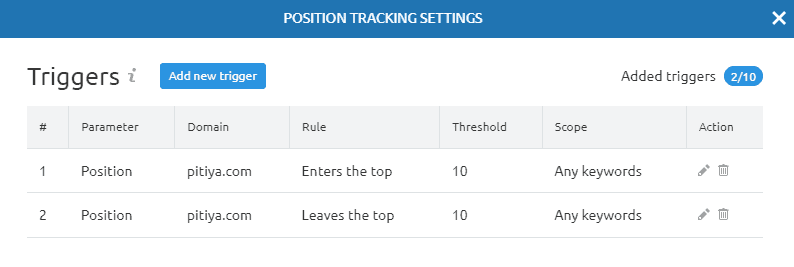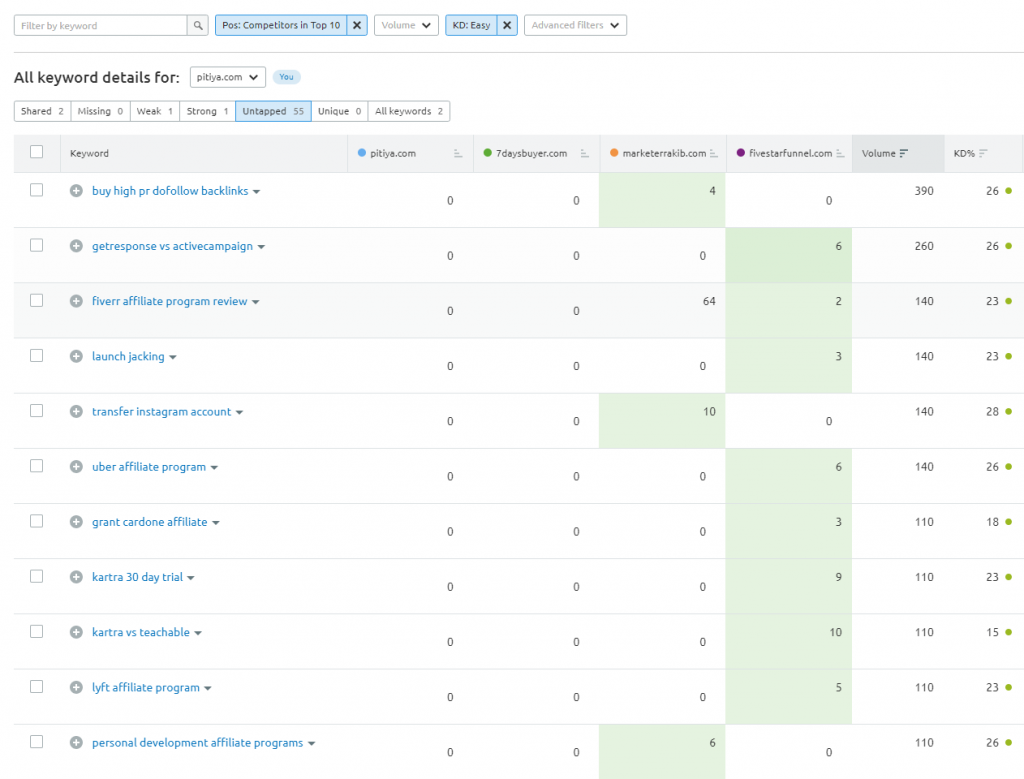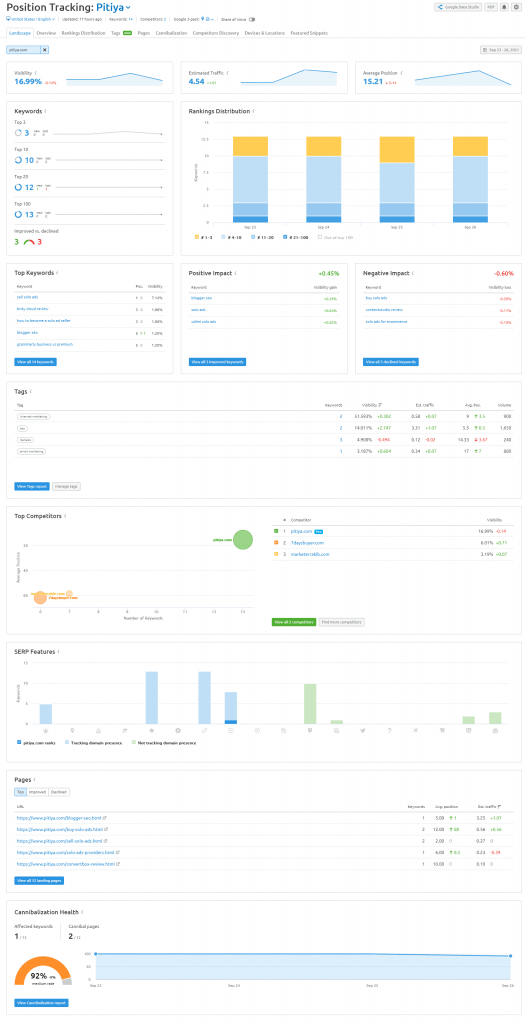Tracking SERP ranking for keywords is essential for any business, whether SEO is a big part of it or not.
Why?
Because some keywords might be driving a significant percentage of clients to your business, you want to be aware of which absolute positions those keywords are ranking on Google.
For the most part, you had to rely on Google Analytics or Search Console to find your website position for a keyword. But, those rankings aren’t real-time updated, and nowadays, many keywords are not provided or not set in Google Analytics.
Nevertheless, In this article, you will find out how to track search engine rankings of keywords and get notifications instantly via email so that you can keep updated on critical metrics that matter to your business.
Also, you will learn how to track local SERP rankings, monitor search engine positions for competitors, and get alerts via email (or push notifications (optional)) when something important happens as your competitor beats you!
Keyword Rank Tracking in Google Search Console
Google Search Console is absolutely a must-have SEO tool for webmasters. However, it is not convenient and flexible for some tasks.
For example, in Search Analytics, Google lists keywords and their average rank position during a period you specify.

And if you wanted to see the current Google keyword rank (today’s), it’s impossible because it takes at least one day for Google to process data and deliver it.
Another disadvantage of using the Google search console for tracking keyword rank position is you cannot find the exact ranking for specific geolocation. For example, if you want to find the keyword ranking in Los Angeles, CA, USA, you cannot accomplish it with Google Search Console.
Why Should You Track Your Keyword Rankings?
There are many reasons you should track keyword rankings immediately for your important keywords. Here are a few of them:
Find out “WHY” your site’s rankings changed
If you’re in a very competitive niche and your websites are ranking on Google’s first page for highly important keywords to your business as a whole, there is no doubt that you should pay close attention to their performance.
Your business might solely depend upon those search queries.
Sophisticated keyword rank tracking software can identify daily ranking fluctuations, so you can adapt to changes and discover why the SERP position is changed.
Here’s a screenshot from a popular online keyword rank tracker app, SEMRUSH.

URL Rank for a specific keyword within a particular region
As you see, it shows the exact rank position for a keyword phrase of a website in a particular area.
Establish your Google keyword rankings
Writing one SEO-friendly article and expecting Google to rank at a certain position on Google consistently is wrong thinking. Due to various reasons like competition and regular Google updates, keyword rank positions are changed more often.
By starting tracking rank positions for keywords, you get to know when rankings are decreased and act accordingly.
Find new ranking opportunities
SEO is a challenging game. And the beauty of it is that it makes smart bloggers stand out. After setting up a keywords SERP tracking campaign, you can identify who is competing with you.
This allows you to run a content gap analysis and find out untapped keyword opportunities. Here is an example:
How to Track Keyword Rankings in Google
Google and Bing are the top search engines in the world. While Google dominantly owns more than 92% search share market worldwide.
I will show you, step by step, how to track keyword rankings in Google engines. Unfortunately, this article doesn’t cover monitoring search engine positions in Yahoo, Baidu, Yandex, and Duckduckgo. But you can assume that if your site ranks at the top of Google for specific keywords, chances are high to rank top on other search engines.
How to Track Keyword Rankings in Google Search Engine(s)
Google has several country-specific domains. For example, when someone in the United Kingdom googles something, they search on Google.co.uk (and related data such as search volume are stored under Google’s UK database).
Follow the steps below to track keyword ranking in Google.
The keyword rank tracking tool I use is SEMRUSH. It is equipped with over fifty different tools to help you grow your business via online marketing.
Previously I talked a lot about Semrush and shared some tutorials on Semrush’s keyword research features such as the Keyword Magic tool, essential SEO reports, and other SEO tools such as backlink checker, toxic backlinks tool, and how to use Semrush for blogging.

Its Position Tracking tool is one of the most used ones because of these key features:
- Monitor the rankings of any domain, subdomain, subfolder, or URL for the keywords you track daily.
- Check your position at the national or local level on mobile or desktop devices.
- Analyze SERP features to boost your SEO strategy
- Discover essential competitors that you might not have identified before
- Get notified of the crucial position changes
- Export rankings as PDF, Excel spreadsheet
Registration
Step 1: First, you must have an active Semrush account. Semrush’s pricing plans include a free tier. But, if you want to remove boundaries and track keywords rankings locally, you need to upgrade to a paid plan.
Luckily, you can open a free Semrush trial account (worth: $119.95) for free.
Click this link and create your free Semrush premium account.

Don’t forget to activate your account by clicking the activation link sent to the email address you signed up with.
Create project
Once logged into your Semrush.com account, go to the SEO Dashboard and click on the ‘Projects’ button to add a project.

Click on the “Create My First Project” green button.

Step 3: Enter your website or blog address into the Domain field and provide a name for your project.
If you enable the ‘Autosetup tools,’ you will be given two more fields to add keywords to track and locations. As you can see in the screenshot below, Semrush allows the following SERPs positions at the ZIP code level.
The allowed keywords limit will depend upon the Semrush subscription.

Then click on the “Create Project” button.
Set up position tracking
In the SEO Project Dashboard area, you can see different tasks you can fulfill with Semrush.

Click on the ‘Set up’ button under the Position Tracking box.
- Site Audit: Get to know technical SEO issues with your site like broken links (internal and external), images without alternative text, meta tags, etc.,
- Position Tracking: Track keyword rankings within the top 100 results in Google and Baidu. We are using this tool today to track keyword ranking.
- On-Page SEO Checker: Product SEO-friendly content with Semrush SEO Writing Assistant.
- Brand Monitoring: Monitor brand mentions on social media.
- Backlink Audit: Analyze your backlink profile and find toxic links and link-building opportunities.
- Organic Traffic Insights: Uncover “not provided” keywords in your Google Analytics account with a few clicks.
Click on the ‘setup’ button under “Position Tracking.”
Once you click the “set up” button, a pop-up box will show up…
Position Tracking Settings
In the Campaign stage, you will be asked to specify the domain (or URL), search engine, Device, location, and Business name for the local map pack.

Domain settings
You will see these options:
- Tracking Root Domain: *.pitiya.com. (all domains will be included in keyword monitoring)
- Tracking Sub Domain: https://www.pitiya.com (Only web pages under the specified sub-domain will be taken into consideration)
- Tracking URL: https://www.pitiya.com/how-to-use-semrush-grow-blog.html
- Tracking subfolder: https://www.pitiya.com/category/ or https://www.pitiya.com/category/seo/
Search engine tracking settings
- Search engine: Google or Baidu. Select Google.
- Device: Desktop, Mobile, Tablet.
- Location: Monitor keyword positions at the Zip code level. Once a location is selected, you will be given another option to choose the language.
- Local Map Pack (optional): Enter the exact full name of your business if you want to track local Google ranking for a business entity.
Add Keywords
The next step is adding keywords you want to monitor.

- Manually: Type each keyword one by one. One keyword per line.
- Campaign: Import keywords from another campaign
- From Semrush: Find keywords to track from the Semrush keyword database.
- From Google Analytics: Connect your Google Analytics account with Semrush and fetch keywords to track ranking.
- From File: Upload a keyword file from your local Device. Supported formats are .txt and .csv.
Which keywords to track?
It depends on your needs. However, I recommend tracking your business’s most important ones, like money keywords that drive sales.
You can find them on your Google Analytics (if you have unlocked, not provided & not set keywords) if you have already started tracking conversion goals.
Note: With Semrush GURU plan you can track up to 1,500 keywords. So, make sure you don’t exceed the keyword allownace. You can create 14 more campaigns.
Once added keywords to your SandBox, click on the ‘Add to project’ button. Tick the box that says ‘Send me weekly updates’ to receive details about rank changes and click on the ‘Start Tracking’ button.

Analyze Google Keyword rankings
Position tracking details will be shown in your SEO Dashboard.

What is Visibility Index?
According to Semrush,
The Visibility index is based on click-through rate (CTR) that shows a website’s progress in Google’s top 100 for keywords from the current tracking campaign. A zero-percent visibility means that the domain isn’t ranking in Google’s top 100 results for any of these keywords; and a 100-percent visibility means that the domain keeps the first position in the SERP for all of these keywords.
Click on the ‘View full report’ button or the ‘Position Tracking’ link.
You will see many details about the keyword positions and their insights on this page. For instance, Ranking distribution over days, keyword positions based on position category, keywords with positive and negative impacts, SERP features, competitors, and cannibalization health are some of those.
Watch this showcase video to see the statistics and graphs you can see.
Add new keywords
Click on the link next to Keywords label at the top and enter new keywords to the campaign.

Add competitors
Click on the ‘Add’ link next to the competitor’s label and add your organic competitors.

Check daily keyword ranking
On the Overview tab of Position Tracking in Semrush, scroll down the page and look for the Ranking Overview section.
Click on the row of a keyword to see its keyword ranking changes.
Ranking distribution
In the Ranking Distribution tab, Semrush Position Tracking tool will represent the keyword ranking of you and your competitors.
Identify new competitors
Semrush Position Tracking looks for every keyword change and lets you know if they found a new competitor.
Get notified by email if there are any changes in rankings
One of my favorite features of the Semrush Keyword Position Tracking tool is email alerts! When you track thousands of keywords, it’s impossible to manually keep an eye on everyone. Instead, you can set up a trigger so that you will get an email notification if a significant change happens.
Click on the ‘gear’ icon at the top right corner and click on the ‘Triggers’ menu link.

There will be two default triggers. They will trigger when a keyword enters or leaves the first page on Google.

Click on Add new trigger button and specify conditions.
Next Steps
Since we used Semrush to check Google SERP position daily, you can now keep updated on rankings on mobile with the Semrush mobile app.
Download it on Appstore (iOS) or Playstore (Android) and give it a try.
Analyze more data given by Semrush, and you will find tons of precious information. Let it a few days to operate. The more data the Semrush position tracker tool collects, the more accurate information, and you can also make the most proper decisions for your SEO and content marketing campaigns.
Have only one variable at a time and change it to see how far dependent variables go. Your controlled variable might be the post title. When you split test post titles and make the winner title the meta post title, you will see changes in CTR, bounce rates, average time on page, and Google keyword ranking modifications.
SEO is a long-term game. It’s not a set-and-forget game, either. If you think and act as a one-off task, you lose at it because Google frequently changes its algorithm to keep up with new trends and technological advances, such as voice search and weeding out low-quality content.
You’re at least one step ahead of your competitors by tracking keyword rankings. Because you can,
- Analyze ranking fluctuations across the entire website and see how your implemented SEO strategies have paid off. Is it in a good way or just in a bad way?
- Identify SEO strategies of competitors. Do they hire SEO services to prominently build backlinks or use influencer marketing (ex: social media promotion, blogger outreach, reviews, banner ads, etc.) to increase rankings indirectly?
- Discover new opportunities. Have you heard about “Red ocean vs. Blue Ocean“? Don’t swim in a place where huge, terrible sharks are hanging around. Find a place where you feel safe and have opportunities where you are confident you can succeed.
- Improve search engine rankings. This is your ultimate goal from an SEO’s point of view. Tracking keyword ranking makes it so much easier for you to keep a good understanding of what worked and what did not work. For example, not too long ago, Google+ directly made a huge impact on search engine rankings. Same with secured pages (i.e., HTTPS). Now, more weight on high-quality content, user behavior, web security (not just SLL certificate but data protection and collection policies), and more factors oriented to people.
If you use Blogspot (Google Blogger), check out this ultimate Blogger SEO guide and check these Tumblr SEO tips if you blog on Tumblr to optimize your site further.
Final words on SERP tracking keyword ranking
As a webmaster, blogger, and internet marketer who uses content marketing and search engine marketing as a tactic to generate more readers, leads, potential customers, and business advocates, you can see the importance of tracking keyword rank in Google.
I don’t know how to insist on this. However, when you started tracking rankings in SERPs, you would see many things you can’t see, just writing and posting articles on your site.
You will start seeing that subtle things significantly impact the overall result. And you will become more sophisticated and even start asking yourself questions like, “is it better off optimizing for a single medium-volume keyword phrase or low-volume keyword phrase?” (Hint: the answer might surprise you.)
Position yourself in the shoes of search visitors before trying to position your blog on SERPs. That’s how I learned a lot of things about SEO and content marketing.
So, how do you find tracking keyword ranking helps in search engine ranking? Leave your comment below to let me know your thoughts.







Great tips Chamal! I was wondering, what is your take in keyword density? do you think it still matters?
Yes, it matters somewhat. But, not highly. User-oriented content will add more terms to search index, so posts will be ranked for more long-tail search queries. When integrating keywords into articles, don’t mind about keyword density. It will be eventually set up after you crafted a good SEO-friendly article.
I see. Thanks Chamal for responding! 🙂